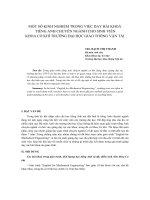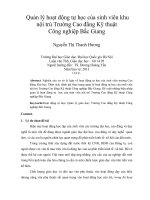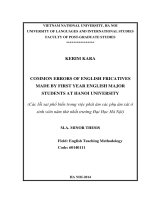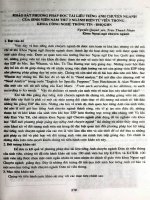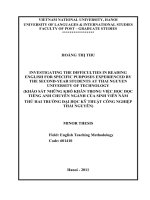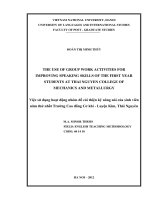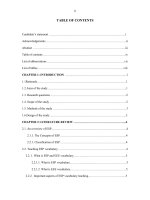Khảo sát những khó khăn trong việc học đọc tiếng Anh chuyên ngành của sinh viên năm thứ hai Trường Đại học Kỹ thuật Công nghiệp Thái Nguyên
Bạn đang xem bản rút gọn của tài liệu. Xem và tải ngay bản đầy đủ của tài liệu tại đây (955.31 KB, 63 trang )
VIETNAM NATIONAL UNIVERSITY, HANOI
UNIVERSITY OF LANGUAGES & INTERNATIONAL STUDIES
FACULTY OF POST – GRADUATE STUDIES
*****************
HOÀNG THỊ THU
INVESTIGATING THE DIFFICULTIES IN READING
ENGLISH FOR SPECIFIC PURPOSES EXPERIENCED BY
THE SECOND-YEAR STUDENTS AT THAI NGUYEN
UNIVERSITY OF TECHNOLOGY
(KHẢO SÁT NHỮNG KHÓ KHĂN TRONG VIỆC HỌC ĐỌC
TIẾNG ANH CHUYÊN NGÀNH CỦA SINH VIÊN NĂM
THỨ HAI TRƯỜNG ĐẠI HỌC KỸ THUẬT CÔNG NGHIỆP
THÁI NGUYÊN)
MINOR THESIS
Field: English Teaching Methodology
Code: 601410
Hanoi - 2011
VIETNAM NATIONAL UNIVERSITY, HANOI
UNIVERSITY OF LANGUAGES & INTERNATIONAL STUDIES
FACULTY OF POST – GRADUATE STUDIES
*****************
HOÀNG THỊ THU
INVESTIGATING THE DIFFICULTIES IN READING
ENGLISH FOR SPECIFIC PURPOSES EXPERIENCED BY
THE SECOND-YEAR STUDENTS AT THAI NGUYEN
UNIVERSITY OF TECHNOLOGY
(KHẢO SÁT NHỮNG KHÓ KHĂN TRONG VIỆC HỌC ĐỌC
TIẾNG ANH CHUYÊN NGÀNH CỦA SINH VIÊN NĂM
THỨ HAI TRƯỜNG ĐẠI HỌC KỸ THUẬT CÔNG NGHIỆP
THÁI NGUYÊN)
MINOR THESIS
Field: English Teaching Methodology
Code: 601410
Supervisor: M.A Nguyen Minh Ha
Hanoi – 2011
TABLE OF CONTENTS
DECLARATION
i
ACKNOWLEDGEMENTS
ii
ABSTRACT
iii
TABLE OF CONTENTS
iv
LIST OF ABBREVIATIONS
vii
LIST OF TABLES AND FIGURES
viii
PART ONE: INTRODUCTION
1
1. Rationale
1
2. Aims of the study
1
3. Methods of the study
2
4. Scope of the study
2
5. Organization of the study
2
PART TWO: DEVELOPMENT
4
Chapter 1: Literature review
4
1. The nature of reading
4
1.1 Definition of reading and reading comprehension
4
1.2 Reading process
4
1.3 Reading comprehension skills
7
2. ESP reading
8
2.1 Definition of ESP
8
2.2 Reading skills in ESP
9
2.3 ESP reading materials
9
3. Reading difficulties for non-native learners
10
3.1 Reading skills problems
10
3.2 Language problems
11
3.3 Cultural and background knowledge and reading difficulties
12
4. Summary
13
Chapter 2: Investigation into the current situation of teaching and
learning ESP at TNUT
14
1. Introduction to Thai Nguyen University of Technology
14
2. Syllabus, materials and assessment
14
3. Teachers and methods of teaching
14
4. Students
15
5. Summary
15
Chapter 3: Research Methodology
16
1. Research questions
16
2. The participants
16
3. The data collection instrument
17
4. Procedure for data collection
18
5. Data analysis
18
Chapter 4: Findings and discussion
19
1. Students‟ attitude towards ESP reading
19
2. Students‟ opinion of ESP reading difficulties
20
2.1 In the area of vocabulary
20
2.2 In the area of grammar
22
2.3 In the area of discourse
24
2.4 In the area of reading skills
26
2.5 In the area of background knowledge
27
2.6. Rank order of ESP reading difficulties
28
3. The causes of difficulties
30
3.1 The reading materials
30
3.2 The teachers
31
3.3 The learners
31
4. Students‟ recommendations for improving reading
32
5. Summary
32
Chapter 5: Pedagogical implications
34
1. Making ESP reading interesting and useful
34
2. Developing ESP reading materials
34
2.1 Adjusting and improving reading exercises
34
2.2 Updating reading texts in the coursebook
35
3. Training students to become efficient readers
35
3.1 Making students aware of the nature of reading process
35
3.2 Making students fully aware of their purpose of reading
35
3.3 Teaching students a variety of reading strategies
36
3.4 Encouraging students to develop extensive reading habits
37
4. Improvement of teachers‟ teaching techniques in the classroom
37
4.1 Employing three phases in ESP reading lessons
37
4.2 Giving homework and checking the previous lessons frequently
38
4.3 Adjusting teaching time and imposing time limits
38
5. Summary
PART THREE: CONCLUSION
39
40
1. Conclusion
40
2. Limitations of the study and suggestions for further study
40
References
42
Appendices
APPENDIX A
I
APPENDIX B
VIII
APPENDIX C
XII
LIST OF ABBREVIATIONS
TNUT: Thai Nguyen University of Technology
ESP: English for Specific Purposes
FL: Foreign Language
GE: General English
L1: First Language
L2: Second Language
M: Mean
SD: Standard Deviation
LIST OF TABLES AND FIGURES
Table 1: Students‟ attitude towards ESP reading
Table 2: The difficulties in the area of vocabulary
Table 3: The difficulties in the area of grammar
Table 4: The difficulties in the area of discourse
Table 5: The difficulties in the area of reading skills
Table 6: The difficulties in the area of background knowledge
Table 7: The average mean of the items in each area of difficulties
Table 8. Learners‟ view of sources of difficulties
Figure 1. Schematization of the Top-down Approach
Figure 2 The vicious circle of the weak reader
Figure 3. Mean number of difficulties in the area of vocabulary
Figure 4. Mean number of difficulties in the area of grammar
Figure 5. Mean number of difficulties in the area of discourse
Figure 6. Mean number of difficulties in the area of reading skills
Figure 7. Mean number of difficulties in the area of background knowledge
Figure 8. Average mean number of areas of difficulties
PART ONE: INTRODUCTION
1. Rationale
Nowadays, English has become more and more important than ever when Vietnam
integrated into the international arena. The number of people who wants to learn
English is increasing, they are trying to learn it with the hope that they can use it
effectively.
In teaching and learning English as a foreign language in Vietnam, reading has
always received a lot of attention for the reason that reading is not only an important
means to get knowledge but also a means of further study.
Students at TNUT learn two semesters of GE in the first year. After that they learn
ESP in the third semester in the second year. During the GE course, they learn all four
skills: reading, writing, listening and speaking. However, when they learn ESP,
reading skill is paid most attention to. These students are future technical engineers so
they have to learn ESP to make themselves familiar with technical materials.
Therefore, they will be able to handle subject-related written materials in English and
work with modern technological equipment. The ability to read English is an important
skill to gain access to knowledge in technology. However, in spite of the efforts of the
teachers and students, the teachers often find their students‟ reading skill disappointing,
which does not meet the requirements of the university. There are many factors which
affect the teaching and learning process such as: unsuitable teaching materials,
inappropriate attitude of the teachers and students towards the subject, inappropriate
teaching methods…etc.
For all the above reasons, I would like to find out the areas of students‟ reading
difficulties at TNUT and the causes of their unsuccessful reading comprehension.
Hopefully, when the results of the study are stated, the students can have some
suggestions to improve their reading skill and use their reading skill more effectively.
2. Aims of the study
This study is designed to find out the areas of difficulties in ESP reading
experienced by the second-year students at Thai Nguyen University of Technology and
the causes of their unsuccessful reading comprehension. The aims of the study are as
follows:
- To investigate the students‟ attitude towards ESP reading.
- To find out the students‟ areas of difficulty and the sources of difficulty.
- To examine the students‟ needs in terms of reading material and teaching
methodology.
- To suggest ways to reduce the difficulties and help them to improve their reading
comprehension.
3. Methods of the study
To achieve the aims of the study, both qualitative and quantitative methods are used.
By means of qualitative method, the researcher has to refer to different materials,
previous researches and relevant issues related to reading and ESP reading. By means
of quantitative method, a survey questionnaire is used. The survey questionnaire is
done on 100 second-year students at Thai Nguyen University of Technology.
4. Scope of the study
Because of the size of this minor thesis, the study is only focused on investigating
some linguistic and reading skills problems and background knowledge difficulties in
ESP reading faced by the second-year students at Thai Nguyen University of
Technology.
5. Organization of the study
The thesis includes three parts.
The first part “Introduction” comprises a rationale for the study, the aims, the
method, the scope of the study and the organization of the thesis.
The second part “Development” consists of five chapters:
Chapter 1 is concerned with the theoretical background related to the research topic
such as the nature of reading, ESP reading and ESP reading difficulties for non-native
learners.
Chapter 2 examines the current situation of teaching and learning ESP reading at
Thai Nguyen University of Technology.
Chapter 3 presents the research methodology with the focus on the research
questions, the participants, the instruments and data collection procedure.
Chapter 4 analyzes the collected data and discusses the findings.
Chapter 5 gives some suggestions to reduce difficulties and improve the teaching
and learning of ESP reading.
The last part of the study “Conclusion” summarizes the findings, points out the
limitations and suggests future research.
PART TWO: DEVELOPMENT
Chapter 1: Literature review
1. The nature of reading
1.1 Definition of reading and reading comprehension
There are many definitions of reading by different authors. Each of them gives it out
from his own point of view. As defined by Goodman (1971:135), reading is “a
psycholinguistic process by which the reader, a language user, reconstructs, as best as
he can, a message which has been encoded by a writer as a graphic display”.
Meanwhile, Harmer (1989:153) described reading as a mechanical process that
“eyes receive the message and the brain then has to work out the significance of the
message”. Sharing the same opinion, Smith (1985:102) defined “reading is
understanding the author’s thought”.
In spite of the difference, all authors try to find out the nature of reading, reading act,
in which readers, reading process and reading message are emphasized.
Reading comprehension plays an important part in teaching and learning a language.
It is the ability to obtain the information from the text as efficiently as possible. There
are three elements involving in the reading process: the text being read, the background
knowledge of the reader and the contextual aspects relevant for interpreting the text.
According to Swan (1975:1), “a student is good at comprehension” if “he can read
accurately and efficiently, so as to get the maximum information of a text with the
minimum
understanding”.
Whereas,
Grellet
(1981:3)
pointed
out
“reading
comprehension or understanding a written text means extracting the required
information from it as effectively as possible”.
Although their ideas are not exactly the same, they all agree that reading
comprehension is the process in which the readers, as they read, can recognize the
graphic forms of the reading text and understand what is implied behind these forms.
1.2 Reading process
There exist three models of reading process: bottom-up, top-down and interactive.
The first model is the bottom-up one: According to Cambourne (1979) it became the
basis of a large number of reading schemes. In this model, the reader begins with the
written text, and constructs meaning from letters, words, phrases and sentences found
within, and then processes the text in a linear fashion. In the process of meaning
interpretation, the language is translated from one form of symbolic representation to
another. (Nunan, 1991)
In this text-driven model, the reader plays a relative passive role as he/she builds
comprehension by moving eyes from letters to letters, words to words, phrases to
phrases, sentences to sentences to identify their exact meaning.
In short, the bottom-up model tends to be linear as it starts with the printed stimuli
and proceed to higher–level stages, one step after another. The basis for bottom-up
processing is linguistic knowledge of the readers. There is now a great deal of evidence
pointing to the shortcomings of the bottom-up reading model. For example, Samuels
and Kamil (1988:31) point out that the lack of feedback, “in that no mechanism is
provided to allow for processing stages which occur later in the system to influence
processing which occurs earlier in the system” makes it “difficult to account for
sentence-context effects and the role of prior knowledge of text topic as facilitating
variables in word recognition and comprehension.”
The second model is top-down model: The reading process moves from the top, the
higher level of mental stages, down to the text itself. In these models the reading
process is driven by the reader‟s mind at work on the text (reader-driven model).
Cambourne (1979:41) provides the following schematization of the approach.
Past experience,
language intuitions
and expectations
→
Selective
aspects of print
Sound,
→
Meaning
→
pronunciation
if necessary
Figure 1. Schematization of the top-down approach
This model emphasizes the reconstruction of meaning rather than the decoding of
form, the interaction between the reader and the text rather than the graphic forms of
the printed page. The reader proves his active role in the reading process by bringing to
the interaction his/her available knowledge of the subject, expectations about how
language works, motivation, interest and attitudes towards the content of the text.
According to Dechant (1991:25) “the knowledge, experience, and concepts that
readers bring to the text, in other words, their schemata, are part of the process…
Reading in this context is more a matter of bringing meaning to than gaining meaning
from the printed page.” What is important in constructing meaning from the printed
material is the reader‟s prior knowledge and cognitive and linguistic abilities.
Clearly, the strong points of top-down models outnumber those of the bottom-up as
the reader – the centre of the reading process proves his active role. However, to some
researchers, these models still reveal certain shortcomings because they sometimes fail
to distinguish adequately between beginning readers and fluent readers. Moreover, a
purely top-down concept of the reading process makes little sense for a reader who can
be stymied by a text containing a large amount of unfamiliar vocabulary. What is more,
in top-down models, the generation of hypotheses would actually be more timeconsuming than decoding (Stanovich, 1980).
The third type - interactive models of the reading process - derives from the
perceived deficiencies of both bottom-up and top-down models. Interactive theorists
appreciate the role of prior knowledge and prediction and at the same time emphasize
the importance of rapid and accurate processing of the actual words of the text.
Rumelhart (1977:573) suggests that reading is a perceptual and a cognitive process.
He believes that the reading process is neither bottom-up nor top-down and
comprehension is the result of the interaction between the two. Comprehension
depends upon how well readers do both.
Stanovich (1980) argues that in Rumelhart‟s interactive model the strength in one
processing stage can compensate for the weakness in another. The problems in both
models can be alleviated and successful reading, then, is an interplay between bottomup and top-down processing.
1.3 Reading comprehension skills
Reading is a complex process involving an interaction between the reader and the
text. Readers use mental activities in order to construct meaning from the text. These
activities are usually referred to as reading skills. To be an efficient reader, one needs
to develop a number of reading skills. And these skills should relate to both the bottomup and the top-down processing.
Nuttall (1982: 65-124) provides a list of main reading skills as follows:
Macro skills
Micro skills
Word-attack skills:
Morphological information; Structural clues; Inference (or
guessing the meanings of unfamiliar words) from context;
Active, receptive, and throw-away vocabulary; Learning to
ignore difficult words; Using a dictionary
Text-attack skills:
(1) Significance and cohesion: Understanding sentence
syntax; Recognising and interpreting cohesive devices;
Interpreting discourse markers
(2) Discourse: Recognising functional values; Tracing and
interpreting rhetorical organization; Recognising the
presuppositions
underlying
the
text;
Recognising
implications and making inferences; Prediction; Integration
and application
Munby (1978) has another list of micro reading skills: Recognising the script of a
language; Deducing the meaning and use of unfamiliar lexical terms; Understanding
explicitly stated information; Understanding information when not explicitly stated;
Understanding conceptual meaning; Understanding the communicative value
(function) of sentences and utterances; Understanding relations within the sentence;
Understanding relations between the parts of a text through lexical cohesion devices;
Understanding relations between the parts of a text through grammatical cohesion
devices; Interpreting text by going outside it; Recognising indicators in discourse;
Identifying the main point or important information in a piece of discourse;
Distinguishing the main idea from supporting details; Extracting salient points to
summarise (the text, an idea, etc.); Selective extraction of relevant points from a text;
Basic reference skills; Skimming; Scanning to locate specifically required information;
Transcoding information to diagrammatic display.
Considering and comparing the above suggested lists of reading skills, it can be seen
that they share some common features and can be grouped into the following main
types: recognition skills, decoding skills and comprehension skills.
When reading a text, the reader must use all these skills. The reader is required to
use his linguistic knowledge as well as background knowledge and both bottom-up and
top-down processing.
2. ESP reading
2.1 Definition of ESP
Over the past decades, an area of ESL that has been a subject of increasing interest
among the theorists in the field is ESP. Many of them have attempted to define ESP in
order to result in a clearer concept.
Hutchinson and Waters (1987:19) explained that “ESP is an approach to language
teaching in which all decisions as to content and method are based on the learner’s
reason for learning.” So an ESP course should differ from a GE course in the selection
of skills, themes, topics, situation and function. All ESP courses should be based on the
learners‟ needs and meet the learners‟ needs.
Strevens‟ (1988) definition of ESP makes a distinction between four absolute
characteristics and two variable characteristics:
- The absolute characteristics of ESP are: designed to meet specific needs of the
learners, related in context (that is in its themes and topics) to particular disciplines,
occupations and activities, centered on language appropriate to those activities in
syntax, lexis, discourse, semantics, and so on, and analysis of the discourse, and in
contrast with GE.
- The variable characteristics of ESP are: may be restricted to skill to be learned (for
example reading only) and may not be taught according to any pre-ordained
methodology.
It can therefore be concluded that the purpose of ESP reading is to develop the
readers‟ reading skills in the contents relevant to their occupations or fields of studies.
2.2 Reading skills in ESP
Dudley-Evans and St. Johns (1998:96) show some of the key skills: selecting what is
relevant to the current purpose; using all the features of the text such as headings,
layout, typeface; skimming for content and meaning; scanning for specifics; identifying
organizational patterns; understanding relations within a sentence and between
sentences; using cohesive and discourse markers; predicting, interfering and guessing;
identifying main ideas, supporting ideas and examples; processing and evaluating the
information during reading; transferring or using the information while or after reading.
Although ESP reading is usually related to particular content areas such as
technology or engineering, the recent trends in ESP seem to share the assumption that
the readers‟ strategies can be generalized across subject boundaries. This means
general reading strategies should be taught to ESP students because, as Hutchinson &
Waters (1987) point out, ESP is not different in kind from any other form of language
teaching and ESP teaching should be based on the principles of effective and efficient
learning.
2.3 ESP reading materials
Materials play an important role in teaching and learning process, especially in
teaching ESP reading. They are considered as a source of language and a learning
support. They are also used for motivation and stimulation and for reference.
ESP is designed to meet specific needs of the learners, so selecting reading materials
is very important. The reading materials must be used for a given purpose-preferably
some application or transfer of information, be designed to encourage the use (or
teaching) of good skills and have follow-up language work that concentrates on what is
transferable. Selecting materials involves making choices and decisions. To make good
choices, we need to have good criteria on which to base the decision. Numerous criteria
such as factors about the learners, the role of the materials, the topics, the language, the
presentation have been put forward for the analysis of materials and each of them has
validity. According to Hutchinson and Waters (1987:107), a good ESP material must
contain interesting texts, enjoyable activities which make the students think,
opportunities for them to use their existing knowledge, skills and content that they and
their teachers can cope with; truly reflect what you think and feel about learning
process; provide clear and coherent unit structure to guide the student through various
activities to maximize the chances of learning; create a balance outlook which both
reflects the complexity of the task, yet make it appear manageable; introduce teachers
to new techniques and provide models of correct and appropriate language use.
3. Reading difficulties for non-native learners
Reading in a foreign language is important to personal development, professional
success and academic studies. However, this can cause considerable difficulties for the
learners. The studies by Jolly (1978), Coady (1979), Yorio (1971) and others indicate
that problems with foreign language reading may exist either in learners‟ reading skills,
language proficiency or cultural and background knowledge.
3.1 Reading skills problems
As for Jolly (1978), one‟s first language reading ability plays a more important role
in reading success than his level of the target language because foreign language
reading requires the transference of old skills, not learning of new ones. Thus students
who fail to read adequately in the first language will fail because they do not possess
„old skills‟ or because they have failed to transfer them. This view is the same as that of
Coady (1979) who asserts that foreign language reading is a reading skill problem, not
a language problem. These two writers believe that if the reader has a poor reading
ability in his mothertongue, then, he cannot read well in a foreign language.
Students‟ limited reading skills create many problems. Students reading in a foreign
language seem to read considerably slower than they reportedly read in their first
language. Some students who read too slowly will easily get discouraged. They do not
know how to use the appropriate ways to move their eyes from word group to word
group. They just look at every single word, and consequently fail to grasp the general
meaning of the passage. Sometimes, readers may encounter a text which is too long.
Readers may know a lot of the vocabulary, and the topic of the text is familiar to them.
Yet they cannot concentrate well on the text and when they get to the last paragraphs,
they cannot recall what they have read in the first ones.
Reading is an active skill, involving guessing and predicting. There are new words,
new structures and ideas in a reading text for every language learner. If he/she does not
have a good guessing ability and can not make full use of grammatical, logical and
cultural clues, he/she will read the text with less understanding than he/she might
expect, and he/she will feel frustrated at the text, and will not want to keep on reading.
As a result of this, the reader is trapped in a vicious circle:
Doesn't understand
Doesn't read much
Reads slowly
Doesn't understand
Figure 2: The vicious circle of the weak reader
(Nuttall, 1982:167)
3.2 Language problems
Yorio (1971:108) argues that reading problems of foreign language learners are due
to the imperfect knowledge of the target language and due to mother tongue
interference in the reading process. According to him, reading involves four factors:
knowledge of the language, ability to predict or guess in order to make the correct
choice, ability to remember the previous cues, and ability to make the necessary
associations between the different cues that have been selected. Therefore, learners
with limited knowledge of the target language might have considerable difficulty when
reading in the target language.
Dealing with a reading text, readers have to face various difficulties. The first and
foremost problem is that the readers may have to work with unfamiliar and difficult
topics. These are called “text problems”. The content of the text might be strange to the
students and the grammatical structures might be also new, too. As a result, they cannot
understand it. The readers will find the text very challenging and might not have any
motivation left to keep on reading.
The second is the “vocabulary problems”. As everyone knows, grammatical
knowledge accounts for a great deal of competence in reading. However, knowledge of
vocabulary is a great deal more important as a factor of reading comprehension than
awareness of grammatical structures (O‟Donnell, 1961: 313-316). Readers encounter a
lot of difficulties in dealing with proverbs and idioms, synonyms and antonyms,
polysemantic and subtechnical vocabulary. Metaphor, metonymy and other types of
transference of meaning also cause great difficulty for readers.
3.3 Cultural and background knowledge and reading difficulties
According to Fries (1963), meaning at the social level is the meaning that transcends
the language code and is related to the background knowledge of the native speakers of
that code. Comprehension of the total meaning of a sentence occurs only when the
linguistic meaning of the sentence is fitted into “a social framework of organized
information”.
Many studies (Steffensen et al., 1979), Carrell, (1981) have demonstrated the effect
of cultural knowledge on the product of comprehension, appealing to the processes of
distortion and elaboration to account for the differences between a recall of text and the
original text. Readers facing with unfamiliar content may mistranslate or misinterpret
the text according to their own cultural experiences.
From what we have discussed, it seems that there are three main factors that affect
reading comprehension: reading ability or reading skills/strategies; language
proficiency or linguistic knowledge; and cultural and background knowledge.
4. Summary
In this chapter, the relevant literature which has helped form the theoretical and
conceptual framework for the present study is presented.
Firstly, it provides an overview on the nature of reading, in which the definitions of
reading and reading comprehension are discussed. Then, the currently dominant
models of reading process are addressed in regard of strong points and drawbacks.
Classification of reading according to the purpose of reading is also mentioned.
Secondly, it also discusses the definition of ESP, ESP reading materials. Finally, it
provides an insight into ESP reading difficulties, which include reading problems,
language problems, cultural and background knowledge.
Chapter 2: Investigation into the current situation of teaching and
learning ESP at TNUT
1. Introduction to Thai Nguyen University of Technology
Thai Nguyen University of Technology (TNUT) has been operated for 45 years. Its
duty is to train students to become engineers in three major fields: mechanical
engineering, electrical and electronics engineering. Every year our university admits
about 2000-2500 learners for a course of study for 5 years. After graduating, our
learners become mechanical, electrical and electronics engineers. In their jobs, they
have to read technical materials a lot. Therefore, the coursebook is used for all of them
including texts of three above fields.
2. Syllabus, materials and assessment
At TNUT, English is taught in two stages. During the first stage (consisting of two
terms), students study General English, focusing on the development of four language
skills: reading, writing, listening and speaking. The textbook is New Headway
elementary. It is taught within two terms, each term has 72 periods. The second stage
lasts one term (36 periods) in which students learn special English related to their field:
English for electrical and mechanical engineering. The coursebook is composed by
teachers of English division. It consists of seven units focusing on the subject matters
of technical engineering, namely:
Unit 1: Engineering – what‟s it all about?, Unit 2: Machines, Unit 3: Engineering
materials, Unit 4: Engines, Unit 5: Electricity, Unit 6: Robots, Unit 7: Computer-aided
in engineering and manufacturing
Regarding the assessment, the commonly-used form includes written achievement
tests (a mid-term and an end-of-term one) and a daily test.
3. Teachers and methods of teaching
Our university has got 15 English teachers, aged from 25 to 50. Thirteen of them
had formal ELT training in different tertiary institutions inside Vietnam, and only two
had an in-service ELT training course. The oldest teacher has nearly 30 years of
teaching experience and the youngest teacher has two years.
Each of us has the duty to teach both GE and ESP. Only three of us have been
training in teaching ESP in Hanoi University of Technology. Therefore we still have to
face many difficulties, of which the lack of the content knowledge and the choice of
appropriate teaching methodologies seem to be the major concerns.
As far as the methodology is concerned, ESP teachers usually employ the traditional
method of teaching in ESP reading lessons. Classes are conducted in the form of
lectures. Most of the time the teachers play a key role in the lesson, being the main
speaker working with the text. The teachers often explain new words, new structures,
and even translate the text into Vietnamese. Students are passive and only ask the
teachers questions when they face difficult structures or words that they cannot find in
the dictionary. And the success rests on how flexible and adaptable the individual
teacher is to respond to the requirement of the new teaching situation.
4. Students
Students at TNUT come from different provinces of the country and have the
following characteristics: Most of the students are male; they have a good sense of
responsibility and self-adjustment and they are highly self-conscious and well-aware of
their purpose in learning.
Although they have learnt English at school, their English proficiency is low
because they come from mountainous areas in the North and Centre of Vietnam. They
did not pay much attention to English. They did not consider English as important as
other subjects which helped them to enter university such as mathematics, physics and
chemistry. Therefore, the first thing teachers have to do is to improve the students‟
level of General English before they can deal with technical subjects matters in this
language.
5. Summary
This chapter has provided an overview of Thai Nguyen University of Technology. It
also presented some information about the students and learning requirements, about
the teachers and their method of teaching ESP. The chapter has discussed how an
English course at TNUT is organized, the textbooks, materials and time allowance for
the course.
CHAPTER 3: RESEARCH METHODOLOGY
In this chapter, the research methodology that has been employed for the
achievement of the aims and objectives of the study is presented. Data were obtained
by using a survey questionnaire. Beside the survey data, additional data were gathered
by other instruments such as informal discussion with teachers and informal interview
with students to provide more information.
1. Research questions
The study was carried out to provide insights into the areas of difficulties in ESP
reading of second-year students of Thai Nguyen University of Technology and the
causes of their unsuccessful reading comprehension. Therefore, it was conducted to
seek answers to the following questions:
1. What are the English reading difficulties that students at TNUT have when
reading technical materials and what is the level of seriousness of each reading
difficulty?
2. What are the causes of these difficulties?
3. What are the students‟ suggestions in terms of technical materials and teaching
methodology to reduce these difficulties?
2. The participants
The participants of the study were 100 second-year students at TNUT. Ten of them
were female and the rest were male. They came from different provinces in the North
and Centre of Viet Nam. Their age was from 19 to 22. Although they had finished New
Headway Elementary, their proficiency of English was varied because their length of
learning English at school (before entering TNUT) was different. Some of them started
learning English at grade 6, others started at grade 10.
The reason for choosing the second-year students for this study is as follows:
students only take ESP course after finishing GE course (New Headway elementary)
which was studied in the first year.
Those students were selected at random to participate in the research. It was difficult
to select a random sample of individuals since students had already been assigned to
different classes. In this case, cluster random sampling was more feasible, which means
that instead of randomly selecting the individuals, the researcher randomly selected the
groups or classes for investigation. This approach is more appropriate and convenient
for the researcher to observe the participants who filled the questionnaires in classes.
3. The data collection instrument
The main instrument for data collection in this study was a survey questionnaire.
Survey questionnaire was chosen because it allowed the researcher to collect a large
amount data in a relatively short time. Therefore, it was certainly valuable for me to
explore the students‟ difficulties in reading ESP.
The questionnaire was constructed based on the literature on ESP learners‟ reading
difficulties, my observation of my students during 4 years of teaching at TNUT and my
discussion with the other teachers of English of the faculty. Before given to the
students, the questionnaire was piloted on a group of 20 second-year students of TNUT
to check if the questionnaire could provide the kind of information it was intended and
if its wordings would cause confusion and misunderstanding to the respondents. After
that, necessary changes were made to improve the questionnaire.
The questionnaire is divided into two main parts: part one aimed to collect
information about the students‟ background which included their place of domicile, the
number of years they had been learning English and their proficiency levels in English
measured by their average marks in English in the first year. Part two aimed at
collecting information about the students‟ attitudes to reading ESP; their difficulties in
reading ESP and the causes and students‟ recommendations. This part includes 10
questions. Questions 1-3 elicited information about learners‟ attitudes towards ESP
reading. Questions 4-8 investigated the areas of difficulties that the learners faced when
reading in ESP. Question 9 explored the causes of the students‟ reading problems.
Question 10 got their opinions about some suggestions to reduce reading difficulties.
The questionnaire was also written in Vietnamese to ensure students‟ accurate
understanding of all the questions before answering them. (See Appendix C)
Beside the questionnaire, informal interviews and small talks with the teachers and
students were conducted to obtain further information for the research.
4. Procedure for data collection
The questionnaire was administered during the class time. Before the questionnaire
was given to the respondents, the researcher explained the purpose of the questionnaire,
the requirement for the respondents and answered any question asked by the
respondents. The respondents were also encouraged to ask if there was anything in the
questionnaire they did not understand. Then they were instructed to take as much time
as they needed to complete the questionnaire.
To make sure the collected questionnaires were all correctly completed, the
researcher asked for permission to have another contact with the respondents after data
collection so that she could clarify any unclear responses.
5. Data analysis
Data from the questionnaire were classified into different categories such as
students‟ attitudes towards the ESP reading, their difficulties in reading ESP in the
areas of vocabulary, grammar, discourse, reading strategies and cultural background
knowledge, the causes of their reading problems, and their expectations of the teachers‟
methodology and materials. Data are analyzed using descriptive statistics and
interpretation. Then the information is displayed in forms of tables and figures.
CHAPTER 4: FINDINGS AND DISCUSSION
This chapter presents the results from the analysis of the data collected from the
questionnaire. The presentation is divided into four parts. The first part presents the
students‟ attitude towards ESP reading. The second part describes the findings on
English reading difficulties faced by TNUT students when dealing with the material.
The third part gives detailed information about the causes of their difficulties. And the
last part discusses some recommendations of the students towards reading materials
and teaching methodology.
1. Students’ attitude towards ESP reading
Three questions in the questionnaire are to explore the students‟ attitudes towards
ESP reading. They were asked to choose among “strongly agree” (SA), “agree” (A),
“disagree” (D), “strongly disagree” (SD). The results are presented in Table 1.
Questions
Percent responses (%)
SA
1. Reading is an important skill in
A
D
SD
35
61
4
0
59
40
0
1
7
44
36
13
ESP learning.
2. ESP reading is very necessary for
our future job.
3. I like reading ESP very much.
Table 1: Students’ attitude towards ESP reading
Based on the table, 35% of students strongly agreed with question 1 and 61%
agreed, which means that 96% considered reading an important skill in ESP learning.
Only 4% did not find reading important. No one chose “strongly disagree” response. In
learning ESP, reading is practiced more than other skills. It helps them to extend their
knowledge about science and technology. This is easy to understand. Our students are
future engineers. In the job, engineers often deal with technical materials. Most of them
are printed in English, even the language of machines is also English. Those who have
a good command of English will work smoothly.
The students are aware of the importance of reading in ESP learning, so nearly all of
them (99%) believed that ESP reading is very necessary for their future job. Only 1%
strongly disagreed.
